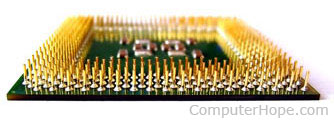What should be the temperature of my computer processor?

The appropriate operating temperature of your processor depends on its manufacturer, top clock speed, where the sensor is located, and which programs it is currently running. However, this page gives you a general idea of what temperatures are acceptable under certain conditions.
Average processor temperatures under full load
The majority of today's desktop processors should not exceed temperatures of 45-50°C when idle, or 80-90°C when under full load. Below is a chart listing many processors and their average temperatures under full load. Acceptable temperatures differ from model to model, and this chart should help give you an idea as to whether or not yours is running within a healthy range.
| Processor | Average temp under full load |
|---|---|
| AMD A6 | 45°C - 57°C |
| AMD A10 | 50°C - 60°C |
| AMD Athlon | 85°C - 95°C |
| AMD Athlon 64 | 45°C - 60°C |
| AMD Athlon 64 X2 | 45°C - 55°C |
| AMD Athlon 64 Mobile | 80°C - 90°C |
| AMD Athlon FX | 45°C - 60°C |
| AMD Athlon II X4 | 50°C - 60°C |
| AMD Athlon MP | 85°C - 95°C |
| AMD Athlon XP | 80°C - 90°C |
| AMD Duron | 85°C - 95°C |
| AMD K5 | 60°C - 70°C |
| AMD K6 | 60°C - 70°C |
| AMD K6 Mobile | 75°C - 85°C |
| AMD K7 Thunderbird | 70°C - 95°C |
| AMD Opteron | 65°C - 71°C |
| AMD Phenom II X6 | 45°C - 55°C |
| AMD Phenom X3 | 50°C - 60°C |
| AMD Phenom X4 | 50°C - 60°C |
| AMD Ryzen | 70°C - 80°C |
| AMD Sempron | 85°C - 95°C |
| Intel Celeron | 65°C - 85°C |
| Intel Core 2 Duo | 45°C - 55°C |
| Intel Core i3 | 50°C - 60°C |
| Intel Core i5 | 50°C - 62°C |
| Intel Core i7 | 50°C - 65°C |
| Intel Pentium II | 65°C - 75°C |
| Intel Pentium III | 60°C - 85°C |
| Intel Pentium 4 | 45°C - 65°C |
| Intel Pentium Mobile | 70°C - 85°C |
| Intel Pentium Pro | 75°C - 85°C |
How will I know if my processor is running too hot?
If a processor gets too hot, you'll have one or more of the following situations.
- Computer runs slowly.
- Computer restarts often.
- Computer randomly turns off.
Continuing to use a computer with a processor that is exceeding its temperature reduces its life expectancy.
Depending on your computer's hardware layout, the thermal sensors may not be positioned in an optimal location. If so, the reported temperature may not be entirely accurate. If your computer's temperature is approaching the maximum, or you're experiencing the issues listed above, you may want to try the following recommendations.
What can I do to get my processor to run cooler?
The cooler a processor runs, the better it performs. Therefore, if you are looking to overclock your processor or it's getting too hot, consider some or all of the following recommendations.
- Keep the computer clean - Over time dust, dirt, and hair can build up and prevent air from getting in or out of the case. Make sure your computer case and ventilation is cleaned.
- Improve computer's environment - Make sure the computer is running in a good location. The computer should not be in an enclosed space (e.g., drawer or cabinet) unless there's plenty of ventilation. There should be at least a two-inch space on all sides of the computer.
- Verify fans - Make sure all fans in the computer are properly working. Some motherboards and computers have fan monitors that display the RPM (revolutions per minute) of each and if they are operating properly. Otherwise, you must check each of the fans and look for any spinning issues or listen for any abnormal noises.
- Thermal paste - If the processor or fan was recently replaced or repaired, you might want to clean it and re-apply thermal paste.
- More fans - Consider installing additional fans into the computer. Nearly all desktop computers come with a processor heat sink and fan, and a case fan. However, most cases accommodate additional fans.
- Alternative solutions - More advanced users or users who are overclocking may also want to consider alternative solutions such as water cooled solutions to keep their processors cool.
My computer displays the temperature in Fahrenheit and not Celsius
Visit our JavaScript Celsius to Fahrenheit converter to convert a Celsius value into Fahrenheit.
Third-party information
For more specific information about the processor you are running, you must either consult your product documentation or visit the Chris Hare's Processor Electrical Specification page.
